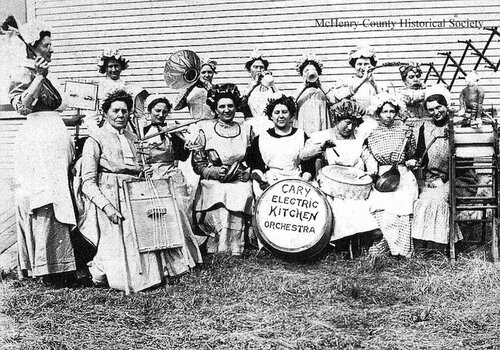MC Women Making History
Check out 11 ways women shaped McHenry County’s history!
1. They blazed a trail. Rachel Harris’ (1838-1907) life began as a Mississippi slave, but that would not define her. It was her work as a nurse for a Union Army hospital that ignited a fateful journey to Marengo where she found freedom, a home of her own and fought for women’s rights. Read more.
2. They gave us escape. Bands and orchestras like the all-women Cary Electric Kitchen Orchestra provided music for an evening’s entertainment (ca. 1900). Read more.
3. They showed conviction. Women stood up for their beliefs and were the ones to organize during the the Temperance Movement. In addition to closing saloons and breweries, the Women’s Christian Temperance Union, founded in 1873, worked for child labor laws, prison reform, and support for rape victims, child care centers and kindergartens, shorter working days and the right to vote. Photo: Harvard Temperance Hall, East Diggins Street, Harvard (ca. late 1890s). Read more.
4. They put food on our tables. McHenry County has strong agriculture roots still intact today, and Amanda Wienke Broederdorf of Algonquin Township had an important role on her family’s farm. She’s pictured here with husband Albert Broederdorf showing samples of their 90-bushels-per-acre yield to Harold Holbinger, farm supply salesman, in 1956. Photo: Don Peasley Photo Collection. Read more.
5. They led. Frances M. Kuhn became Illinois’ first female mayor of a town of more than 5,000 when she took the helm as Woodstock’s mayor from 1965-1969 and again from 1977-1985. Photo: Don Peasley Photo Collection. Read more.
6. They connected us. Who you gonna call? No one without telephone operators. Switchboards were almost entirely staffed by women from 1890s-1970s. Pictured is McHenry’s telephone exchange in the Stoffel building on the northeast corner of Main and Front streets (ca. 1900). Read more.
7. They suited up. A literal walking billboard, Alice Filmore Otis posed for an advertising photograph to promote her husband’s drug/grocery store in Marengo (ca. 1880s). Read more.
8. They healed us. During World War I, every town in McHenry County was organized into local Red Cross chapters or auxiliaries. Pictured are volunteers in Union (the Elgin and Belvidere Electric railway station on Jefferson Street is in the background). They made surgical dressings, hospital garments, knitted goods and assembled comfort kits (ca. 1914-18). Read more.
9. They took charge. Mary Burns Axtell, far left, took over as director of husband Everett Lyle Axtell’s family bank in Harvard after he died. During World War II, she was active in the American Red Cross and made many trips to Camp Grant in Rockford (ca. 1890s).
10. They taught us. In the early 1900s, American schoolteachers were primarily women, and they laid a strong foundation for future generations. Pictured is Miss Mildred Stevens and William Johonnott with pupils, Ringwood School class photo, 1907.
11. They gave us a name. In 1839, Harriet Tryon named Hebron Township after her favorite hymn, “Old Hebron.” It’s the only instance in McHenry County that a women has named a township division. Read more.











